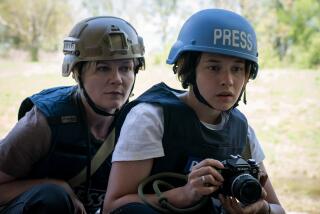Taking his best shot: 100-year-old WWII photographer recounts remarkable life

After a century of life, Joe Renteria has plenty of stories.
He’s hopped freight trains, landed behind enemy lines, sailed into battle, photographed a nuclear mushroom cloud blooming above the South Pacific.
Yet Joe Renteria’s most daring mission may have come while entertaining youngsters.
Five years ago, the San Diego American Indian Health Center hosted a family outing at Admiral Baker Park. Board chair Paula Brim was enjoying herself until she saw fellow board member Renteria stilt-walking through a gaggle of children.
At the time, Renteria was 95.
“Oh my God,” Brim told herself, “we’re going to have to call 911!”
No need. Renteria emerged in his usual unscathed, unruffled fashion. Born 100 years ago in Emporia, Kan., to parents who abandoned him, he’s packed a long life with adventure and accomplishment, serving the U.S. Army, the Navy, San Diego State University and a host of Indian social service agencies.
A witness to history, he doesn’t see himself as a historic figure. He relates even jaw-dropping episodes of his exceptional life in a cool, matter-of-fact tone. Even when outlining his difficult beginnings, there’s no trace of self-pity or anger.
“Here’s the remarkable thing about Joe,” Brim said. “He had no childhood. He’s been on his own his whole life, if you think about it. But he didn’t go down the path a lot of people would have — he’s never touched a drop of alcohol, never used drugs, never given up.
“To me, he is remarkable.”
One of Renteria’s earliest memories is of a bully taunting him in the Catholic orphanage in Kansas both boys called home. Renteria has always been athletic — he was a skilled defender on basketball courts, a smooth operator on skating rinks — and proud. Words led to blows, and Renteria flattened his tormentor.
His victory was brief. After the fight, Renteria was expelled.
At the time, he was 8.
Overnight, this Cherokee boy became homeless. He was alone, without family, money or connections. What could he do? Where would he go?
Everything and everywhere.
Sealed orders
Today, Joe Renteria stands 5-foot-4. He’s lean and weathered, his gray hair braided and falling halfway down his back. He lives with his son, Michael, and Michael’s wife, Susan, in the house father and son built on a Point Loma hillside.
“Took us about 11 years,” Michael Renteria said.
While the house is full of vintage cameras and photos, there are few items from Joe Renteria’s hardscrabble childhood. He ran away from several orphanages, hitching rides on freight trains bound for random destinations: Wisconsin, California, New Mexico. In that last state, the little hobo briefly fell in with Ringling Bros. and Barnum & Bailey.
“I set up, cleaned up, fed animals,” he recalled.
At 16, he entered Boys Town. Father Edward Flanagan, the Nebraska orphanage’s founder, noted that the new boy — a non-Catholic — didn’t attend Mass with the other youth.
“I could order you to to go to church,” the priest said. “But I would appreciate it if you would.”
Nearly 85 years later, Renteria view that moment as a turning point: “That was the key word — ‘appreciate.’ So I did it.”
The teen grew to admire Flanagan. “He was a very loving type of person,” Renteria said of the priest, who would be portrayed in the 1938 film, “Boys Town,” by Spencer Tracy. “He was always walking around, saying the rosary and stopping to talk to the kids, asking them what they had gone through.”
Boys Town placed Renteria in a nearby farmer’s home. It was a bad fit — the farmer worked the boy hard while ignoring his education and skimping on food. The teen resented the poor treatment. Flanagan took note and moved Renteria to another family, the Rounds.
“They gave me a beautiful welcome,” Renteria said.
He remembers the Rounds with affection and gratitude, but this was a temporary haven. After graduating from Boys Town in 1935, the young man joined the Army, where he was trained as a machine gunner.
When his three-year term ended, Renteria left the Army and enlisted in the Navy. His motivation? Self-preservation. “I was a machine gunner and machine gunners don’t live long.”
The Navy turned him into an aviation mechanic and sent him to North Island. There, he developed a sideline as a photographer and pursued Jill Roath. Far apart in age — she was almost nine years his senior — they were close in more important ways.
They wed in 1939. “We were married 71 beautiful years,” Renteria said.
The Navy moved the Renterias from San Diego to Hawaii, then shipped Joe to Florida for photography school in summer 1941. Returning to Hawaii in 1942, he helped recover ammunition from American ships shattered by Japanese bombs at Pearl Harbor.
One day, a lieutenant handed sealed orders to Renteria and hustled him aboard an Army troop transport. Landing in New Caledonia, Renteria was directed to the staff of Adm. William “Bull” Halsey, then commander of a South Pacific carrier task force.
His confidential orders led to confidential missions.
Three presidents, one first lady
In the Pacific, the U.S. military adopted an “island hopping” strategy, ousting enemy forces from one Pacific atoll and archipelago after another, closing in on Japan’s home islands.
Before an invasion, frogmen surreptitiously landed on beaches, scouting the best routes to the interior. The divers were accompanied by Renteria, who captured the evidence on film.
“These were surveying units,” Renteria said. “We’d also fly overhead during the day, taking pictures from about 5,000 feet.”
These were difficult missions for a demanding boss, but the photographer was devoted to Halsey. “He was very conscious of what he wanted and when he wanted it,” Renteria said. “He didn’t waste words or steps.”
Renteria furtively shot photos behind enemy lines at Guadalcanal, Bougainville and other strategic islands. Ashore, his assignments were less hazardous but often no less interesting. In 1943, Eleanor Roosevelt made an unannounced visit to New Caledonia. Renteria’s shot of the first lady flanked by Army Gen. M.F. Harmon and Halsey appeared in newspapers across the country.
Most of Renteria’s wartime work was classified, and he owns few of the photos. Exceptions include the Roosevelt portrait, shots of ruined Japanese warships billowing smoke and U.S. squadrons flying in formation over the Golden Gate.
There are also photos of dignitaries at the 1945 San Francisco conference that gave birth to the United Nations, and postwar shots of U.S. atomic bomb tests in the Pacific Proving Grounds. For the Navy, he filmed the inaugurations of Presidents Truman and Eisenhower.
(Later, he’d photograph a third president, Kennedy, addressing San Diego State College’s graduating Class of 1963.)
Renteria left the Navy in 1955, retiring as a chief petty officer. He freelanced for a year, shooting photo finishes and paddock scenes at the Del Mar and Caliente racetracks. He got a kick out of meeting touts, jockeys and the occasional celebrity.
“When Bing Crosby won,” Renteria said with a laugh, “he’d order a dozen 8x10 prints.”
Working the system
In 1956, he was hired by San Diego State College to run the school’s photo lab. He made slides for classroom presentations, shot campus events for State’s, developed film for students and professors.
Off campus, an acquaintance introduced him to a financially-troubled Indian nonprofit.
While proud of his Cherokee heritage, Renteria had not been involved in tribal affairs. “I never really had been part of the group,” he said. Yet at the first board meeting he attended, he was elected board chair.
Taking charge, Renteria immediately clamped down on expenses. When an officer flouted the new financial rules and won the board’s backing, Renteria resigned.
Three years later, he was invited back when the group agreed to his terms.
“We were going to do this the strict military way,” he said.
Over the years, Renteria’s hard-nosed approach was enlisted by numerous nonprofits: Indian Human Resources Center, Indian Child Services, Indian Health Services.
“He was probably the chairman of five or six Indian organizations,” said Randy Edmonds, founder of the Indian Human Resources Center. “It seemed like he was everywhere.”
He had a knack for working the system, knowing when and how to tug on the levers of power. When Renteria led the San Diego American Indian Health Center in the 1990s, he and his staff flew to Washington to lobby for funds.
“We begged, borrowed but never stole,” said Lisa Mann, who served as Renteria’s vice chair. “We were just a little urban Indian clinic and keeping it open on a daily basis was definitely a struggle.”
Ushered into a Senate committee, the San Diego delegation was informed that each member could speak, but the entire presentation would be limited to 15 minutes.
Well,” Mann said, “Joe doesn’t tell you anything in 15 minutes. He pretty much exhausted the time for our coalition. But not one of the senators interrupted or cut him off. Not one. They listened to him.”
The San Diegans returned home with a federal grant.
While Renteria is retired — he left State in 1988 and resigned his various chairmanships years ago — his advice is still sought.
“Joe is just a revered elder in our community,” said Brim. “Indian custom is to revere our elders for their wisdom and knowledge. But with Joe it’s also because of the person he is, all the things he’d done for our community over the years of his life.”
Today, it’s hard to imagine Renteria as a lonely orphan. While his beloved Jill died in 2009 at the age of 101, he has three daughters and a son, numerous grandchildren and great-grandchildren.
Then there’s the guest list for his 100th birthday party, scheduled for Saturday at Admiral Baker Park.
“We expect about 150 people,” said Susan Renteria, Joe’s daughter-in-law.
.Family, friends, legacy. In a long life, Joe Renteria has come a long way.
More to Read
Sign up for The Wild
We’ll help you find the best places to hike, bike and run, as well as the perfect silent spots for meditation and yoga.
You may occasionally receive promotional content from the Los Angeles Times.











